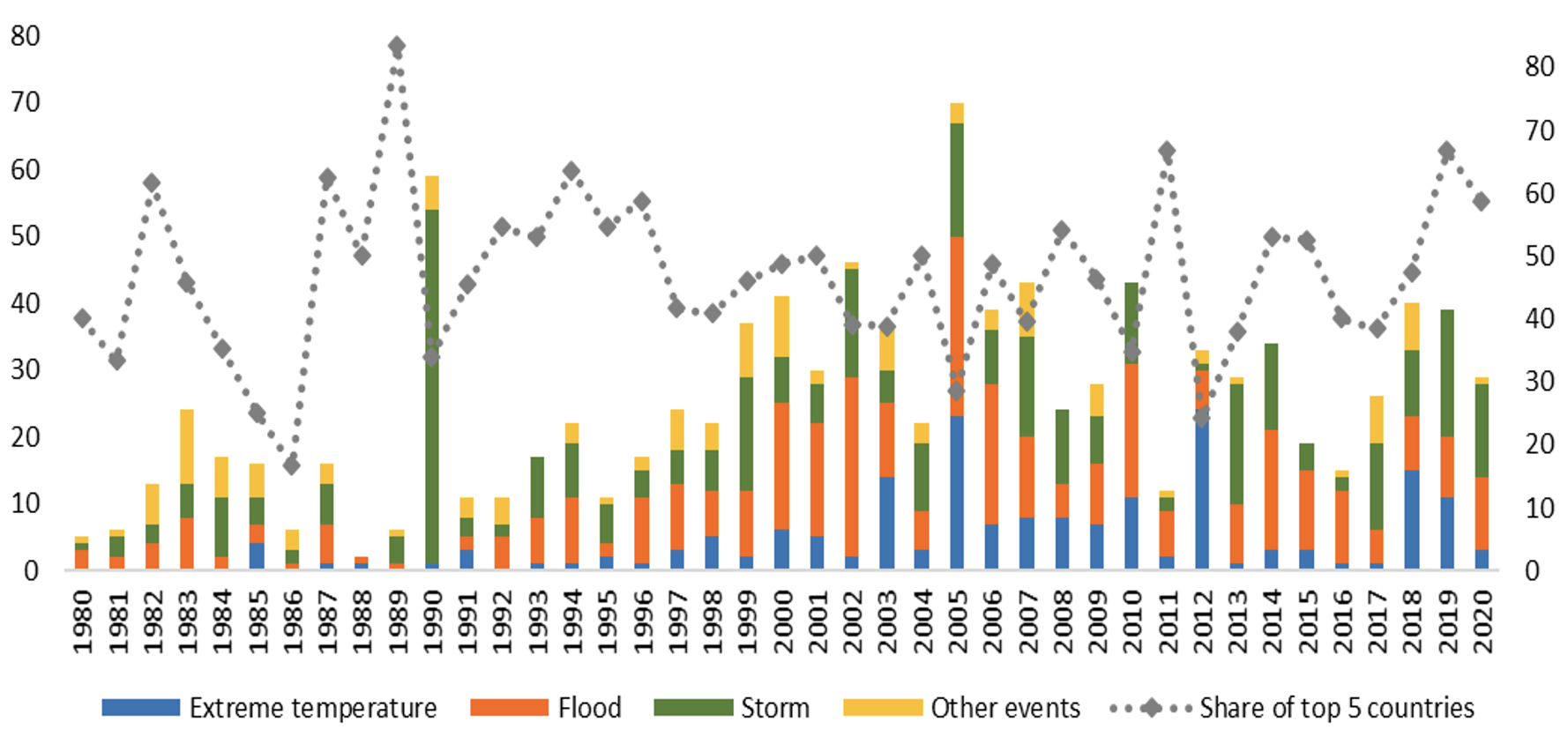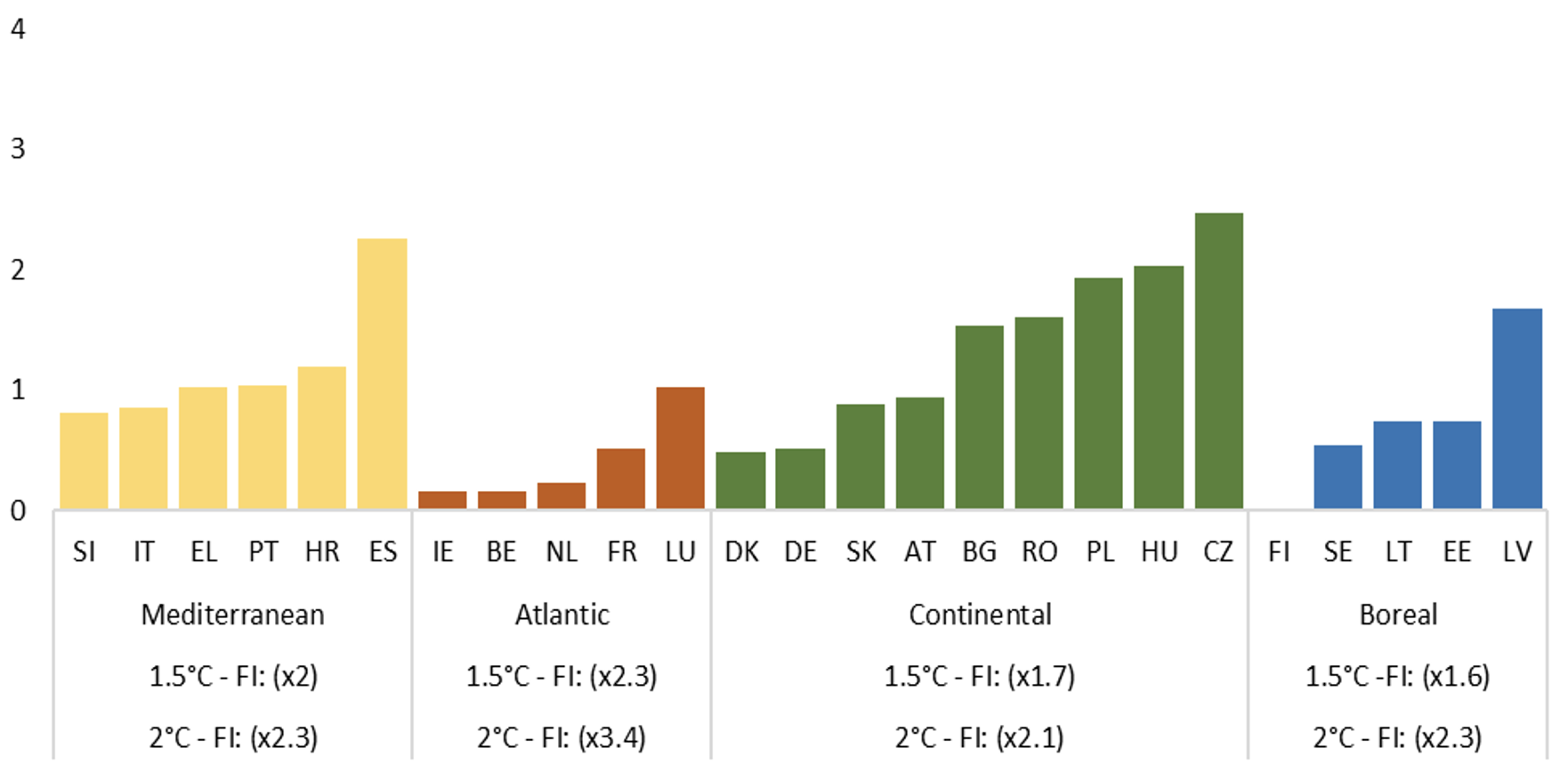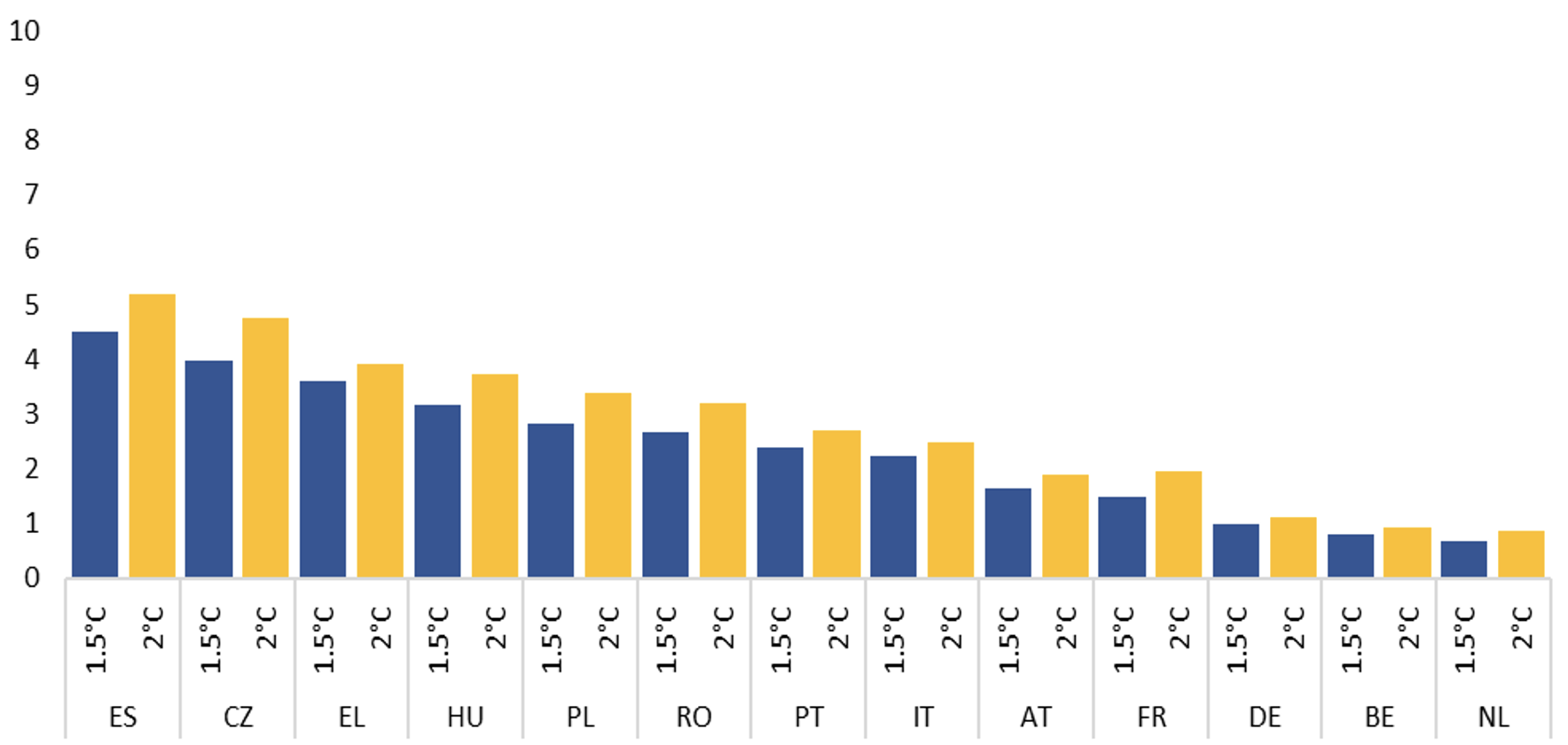Climate change is the challenge of our time. There is broad scientific consensus that human activities are unequivocally responsible for the observed increases in greenhouse gases (GHGs) concentration in the atmosphere. As a result, global temperature has been increasing markedly over the past century (IPCC 2021).
To meet this existential challenge, Europe has set the ambitious goal to be the first climate-neutral continent, with the European Green Deal aiming at climate neutrality by 2050, and the recent ‘Fit for 55’ package thriving at cutting net emissions by at least 55% by 2030. The European Commission also adopted its new EU Strategy on adaptation to climate change in February 2021.
Human-induced climate change has increased the risks of physical hazards,
either occurring via a gradual (often irreversible) global warming-driven transformation of the environment (chronic physical risks), or via more intense and frequent extreme weather events (acute physical risks) (IPCC 2022). Every additional 0.5°C of global warming is likely to cause a significant increase in both the intensity and frequency of extreme weather events, such as severe heatwaves, heavy precipitations, and droughts (IPCC 2021). The risk of nonlinearities and tipping points may further increase the likelihood for catastrophic and irreversible outcomes to occur (Lenton et al. 2019).
Recent evidence highlights that climate change-driven physical risks entail economic and fiscal consequences. Adverse economic impacts may occur through shocks to the supply and demand side of the economy caused, among others, by damage and disruption to critical infrastructure and property, reduced labour supply and productivity, lower consumption and investment, and disruption to global trade flows (Batten et al. 2020; Batten 2018).
Public finances are likely to be affected via multiple and complex channels. Physical hazards could put direct pressures on public spending (e.g. to replace damaged assets, due to needed social transfers and subsidies). The materialisation of contingent liabilities (e.g. in case of distressed financial institutions) could also directly affect public finances. Additionally, tax revenue could be reduced due to output losses following disruptions of economic activity in climate-sensitive sectors and regions. Vulnerability to climate change might even affect the creditworthiness of most exposed countries, and thus their international financing conditions and market accessibility (Radu 2021, Zenios 2021, European Commission 2020). The transition to a decarbonised economy is also expected to have important macroeconomic, structural and budgetary implications (Beetsma et al. 2022).
Despite these expected substantial impacts, the impact of climate change on public finances remains poorly understood and surrounded by large uncertainties. In recent work (Gagliardi et al. 2022), we assess the potential impact of acute physical risks from climate change on public finances. This is done by means of stylised stress tests, for selected EU member states, in the context of the standard European Commission’s Debt Sustainability Analysis (DSA) risk framework. In particular, our aim is to capture the impacts on the public debt dynamics arising from extreme weather events.
Past and future trends of extreme weather events in the EU
Based on a global natural disaster database (EM-DAT; CRED 2020), over 1980-2020, the EU experienced a total of 1,040 weather and climate-related disasters (Figure 1). Storms and floods accounted for almost 70% (35% each) of all reported disasters, alongside extreme temperature episodes (18%) and, to a lesser extent, wildfires (8%), droughts (3%), and landslides (2%).
A country level analysis reveals that, in terms of reported events, some countries have been struck harder than others (e.g. France, Italy, Spain, Romania and Germany). Moreover, over the past 20 years, Central Eastern European countries have experienced the most important increase in the number of disasters (Gagliardi et al. 2022).
Figure 1 Number of weather events in the EU, by disaster subgroup, 1980-2020
Note: The LHS represents the number of weather events, by disaster subgroup, over 1980-2020. The RHS illustrates the number of weather events occurred in the top-5 affected countries (i.e., France, Italy, Spain, Romania and Germany) as a share of total weather events in the EU, over 1980-2020.
Source: Gagliardi et al (2022), based on The Emergency Events Database (EMDAT; CRED, UCLouvain).
During the same period, economic losses accounted for a total of 3% of GDP on average across the EU. The annual average economic losses thus amount to less than 0.1% of GDP.
Although this overall figure appears small, it masks distributional differences, with significant variations over time and across countries. For example, single events are estimated to have cost up to 3% of GDP in some member states. Economic losses data are also very likely to suffer from underreporting.
Moreover, according to forward-looking estimates (European Commission 2022), economic losses are expected to substantially increase in the coming decades as a result of climate change (Figure 2).
Figure 2 Economic losses associated with extreme weather events (historical and forward-looking estimates), by country and regional aggregates (% of GDP)
Note: For each country, the bars represent – for each country - the highest uninsured economic losses (as a share of GDP) associated to a single ‘extreme weather event’ observed over 1980-2020 as reported in the EM-DAT dataset. The forward-looking estimates for the 1.5°C and 2°C warming scenarios represent the Factor Increase (FI) of economic losses due to extreme weather events estimated from the PESETA IV project (Feyen et al., 2020). Regional aggregates are as in the PESETA IV project. The projected economic impacts assume no adaptation measure is in place.
Source: Gagliardi et al (2022), based on The Emergency Events Database (EMDAT; CRED, UCLouvain) and the PESETA IV project (Feyen et al. 2020).
Acute physical risks and potential impacts on public debt
Our scenario analysis makes an innovative use of past historical data on economic losses from extreme weather events (EM-DAT) and forward-looking estimates based on the PESETA study (Feyen et al., 2020). In particular, in order to account for likely interactions between climate change and the expected intensity/frequency of extreme weather events, the scenarios are calibrated according to different global warming scenarios (1.5°C and 2°C).
Our analysis also builds on the recent empirical literature of the macroeconomics of disasters (Fache Rousová et al. 2021).
In a given country, we look at the deviation from the European Commission’s ten-year baseline debt-to-GDP projections,
should a past extreme weather event
reoccur in the medium term. In each scenario, the specific extreme event is assumed to impact the debt dynamic via two main channels: (1) a direct impact on the primary balance; and (2) an indirect impact via GDP (growth and level) effects.
The stress tests are carried out for a set of EU member states identified as the most exposed and vulnerable countries, based on specific selection criteria.
These are Spain, Romania, Portugal, Czechia, Hungary, Poland, Greece, Italy, Austria, France, Belgium, Germany, and the Netherlands.
Our results show non-negligible fiscal impacts in some countries, with debt-increasing effects of up to 5 percentage points of GDP (compared with baseline results). Moreover, these impacts are found to be persistent over time, adding to existing debt vulnerabilities.
The adverse fiscal impact is higher under more severe projected warming scenarios (Figure 3).
Figure 3 Debt-to-GDP difference, 1.5°C and 2°C scenarios compared to the baseline, in 2032 (percentage points)
Note: We rely on the standard projection horizon of the European Commission’s Debt Sustainability Analysis framework (up to 2032, based on the Commission Autumn Forecast 2021 - see European Commission, 2022).
Source: Gagliardi et al (2022), based on The Emergency Events Database (EMDAT; CRED, UCLouvain) and the PESETA IV project (Feyen et al. 2020).
Our analysis represents a first step to quantify, in a harmonised way, the potential fiscal impacts of (acute) physical risks from climate change. It confirms the relevance of climate-related disasters as an additional source of risk to debt sustainability. The contained impacts found in this analysis suggest that such risks would be manageable under standard global warming scenarios. At the same time, our results are likely to represent a lower bound estimate, notably due to underreporting of economic losses in global disaster databases and to the uncertainty surrounding future developments. Risks from non-linearities and tipping points, potential negative feedback effects across sectors, and/or adverse spillover effects across countries are in particular not reflected in the analysis.
Hence, more needs to be done to assess the fiscal implications of climate change and climate-related policies.
Our findings support calls for increased policy attention to address the ‘climate protection gap’ and the need to strengthen climate-related risk management and financing frameworks, both at national and EU levels. In addition, they underscore the need to adopt decisive mitigation and adaptation policies, including insurance and climate-resilient debt instruments, to boost countries’ financial resilience to climate change and dampen the potential fiscal impact of climate-related events in the long term. Concerted action towards ambitious global and EU climate targets remains essential to reduce countries’ exposure and vulnerability to climate change.
References
Batten, S (2018), “Climate change and the macro-economy: a critical review”, Bank of England Staff Working Paper, No. 706.
Batten, S, R Sowerbutts and M Tanaka (2020), “Climate change: Macroeconomic impact and implications for monetary policy”, Ecological, Societal, and Technological Risks and the Financial Sector, 13-38.
Beetsma, R, M Bordignon, M Busse, X Debrun, M Gabrijelcic, L Jankovics, M Larch, J Malzubris, M Szczurek and N Thygesen (2022), “Public finances and climate change in the post-pandemic era”, VoxEU.org, March.
CRED – Centre for Research on the Epidemiology of Disasters (2020), The Human Cost of Disasters (2000–2019), United Nations Office for Disaster Risk Reduction (UNDRR).
European Commission (2020), “Debt Sustainability Monitor 2019”, European Economy — Institutional Paper, 120, January.
European Commission (2022), “Fiscal Sustainability Report 2021”, European Economy — Institutional Paper 171, April.
Fache Rousová, L, M Giuzio, S Kapadia, H Kumar, L Mazzotta, M Parker and D Zafeiris (2021), Climate change, catastrophes and the macroeconomic benefits of insurance, Financial Stability Report, European Insurance and Occupational Pensions Authority, July.
Feyen, L, J C Ciscar, S Gosling, D Ibarreta and A Soria (2020), Climate change impacts and adaptation in Europe, JRC PESETA IV final report (No. JRC119178), JRC Science for Policy Report, Joint Research Centre, European Commission.
Gagliardi, N, P Arévalo and S Pamies (2022), “The Fiscal Impact of Extreme Weather and Climate Events: Evidence for EU Countries”, European Economy, Discussion Paper 168, European Commission.
Hallegatte, S, A Vogt-Schilb, J Rozenberg, M Bangalore and C Beaudet (2020), “From poverty to disaster and back: A review of the literature”, Economics of Disasters and Climate Change 4(1): 223-247.
IPCC (2018), Global warming of 1.5°C. An IPCC Special Report on the impacts of global warming of 1.5°C above pre-industrial levels and related global greenhouse gas emission pathways, in the context of strengthening the global response to the threat of climate change, sustainable development, and efforts to eradicate poverty (in press).
IPCC (2021), “Summary for Policymakers”, in Climate Change 2021: The Physical Science Basis. Contribution of Working Group I to the Sixth Assessment Report of the Intergovernmental Panel on Climate Change, Cambridge University Press.
IPCC (2022), “Summary for Policymakers”, in Climate Change 2022: Impacts, Adaptation, and Vulnerability. Contribution of Working Group II to the Sixth Assessment Report of the Intergovernmental Panel on Climate Change, Cambridge University Press. In Press.
Lenton, T M, J Rockström, O Gaffney, S Rahmstorf, K Richardson, W Steffen and H J Schellnhuber (2019), “Climate tipping points—too risky to bet against”.
Radu, D (2021), “Disaster Risk Financing: Main Concepts and Evidence from EU Member States”, European Economy — Discussion Paper, 150, European Commission.
SwissRE Institute (2021), “The economics of climate change: no action not an option”, April.
von Peter, G, S von Dahlen and S and Saxena (2012), “Unmitigated disasters? New evidence on the macroeconomic cost of natural catastrophes”, BIS Working Papers, No. 394.
Zenios, S A (2021), “The risks from climate change to sovereign debt in Europe”, Available at SSRN 3891078.









